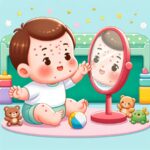Nappy rash is a common concern among new parents, characterized by red, irritated skin in the diaper area. This condition can make a baby uncomfortable and fussy. Understanding what causes nappy rash and how to treat it effectively is essential for maintaining your baby’s comfort and health. In this article, we’ll explore the ins and outs of nappy rash, including prevention strategies and home remedies.
What is Nappy Rash?
Nappy rash is an irritation of the skin around the baby’s diaper area. It’s most commonly caused by prolonged exposure to a wet or soiled diaper, which can lead to skin inflammation. Other contributing factors include diaper friction, sensitive skin, and the introduction of new foods, which can change the acidity of a baby’s stool. Recognizing the signs of nappy rash early is crucial in preventing its escalation.
Common symptoms include redness, swelling, and tenderness in the diaper area. In more severe cases, blisters or open sores may appear. If left untreated, nappy rash can lead to bacterial or yeast infections, making it more challenging to manage.
Preventing Nappy Rash
Prevention is key when it comes to nappy rash. Frequent diaper changes are crucial to keep the skin dry and clean. Opt for superabsorbent disposable diapers or cloth diapers with a high-absorption liner to minimize moisture. Applying a barrier cream that contains zinc oxide can also protect your baby’s skin from irritation caused by contact with urine and feces.
Ensuring the diaper isn’t too tight is another important factor, as it can cause chafing and hinder air circulation. Giving your baby some diaper-free time each day can also help the skin breathe and heal. Moreover, when introducing new foods, monitor your baby’s skin for any signs of increased irritation, as dietary changes can sometimes trigger or exacerbate nappy rash.
Treating Nappy Rash
If your baby does develop nappy rash, prompt treatment can help soothe their skin and prevent further discomfort. Start by ensuring the diaper area is clean and dry. Gently clean with water and a soft cloth during each diaper change, avoiding wipes with alcohol or fragrance, which can irritate sensitive skin. After cleaning, pat the area dry or allow it to air-dry before putting on a new diaper.
Applying a thick layer of a zinc oxide-based diaper cream can provide a protective barrier on the skin. For severe cases, your pediatrician may recommend a mild hydrocortisone cream or an antifungal cream if a yeast infection is present. It’s also important to switch to superabsorbent diapers to ensure the skin remains as dry as possible. For additional guidance on diapering and managing nappy rash, consider reading about diaper rash strategies.
When to See a Doctor
Most cases of nappy rash can be managed at home with proper care and treatment. However, if the rash doesn’t improve within a few days, or if your baby develops a fever, blisters, or pus-filled sores, it’s important to seek medical advice. These symptoms could indicate an infection that requires prescription medication.
Additionally, persistent nappy rash might be a sign of an underlying condition, such as atopic dermatitis or a food allergy. A healthcare professional can provide a proper diagnosis and tailor a treatment plan to your baby’s specific needs.
Home Remedies for Nappy Rash
Alongside medical treatments, there are several home remedies that can help soothe nappy rash. Oatmeal baths can reduce inflammation and irritation. Simply add a tablespoon of colloidal oatmeal to your baby’s bathwater. Breast milk, known for its natural healing properties, can also be applied to the affected area. Additionally, coconut oil has antimicrobial properties and can act as a moisturizer, providing relief for dry, irritated skin.
Avoiding baby powders that contain talc is essential, as they can be harmful if inhaled by your baby. Instead, opt for cornstarch-based powders if you choose to use a powder to keep the diaper area dry. Remember, every baby is different, and what works for one may not work for another. It’s important to observe how your baby’s skin responds to different treatments and adjust accordingly.
Conclusion
Nappy rash is a common yet manageable condition that new parents can effectively treat with the right knowledge and care. By understanding the causes, implementing preventive measures, and applying appropriate treatments, you can ensure your baby remains comfortable and rash-free. Remember, when in doubt, consulting with a healthcare professional is always the best course of action.
For more information on baby health and wellness, visit BabyWhysAndHows.













